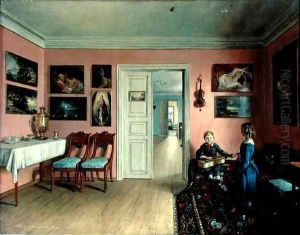Iwan Chrutsky Paintings
Iwan Chrutsky, also known as Ivan Khrutsky, was a prominent Belarusian-Polish painter associated with the realism movement, particularly known for his still life works and portraits. Born on January 22, 1810, in Ulla, Vilna Governorate (now in Belarus), Chrutsky was part of the Polish-Lithuanian Commonwealth aristocracy. His artistic journey began under the tutelage of Józef Oleszkiewicz at the Vilnius University, where he studied from 1826 to 1830. His early influences were deeply rooted in the academic tradition, which provided a solid foundation for his later works.
Chrutsky's paintings often reflected his attention to detail, the use of light and shadow, and his ability to capture the texture of the objects he depicted. His still lifes, which often included flowers and fruits, were particularly admired for their realism and composition, and they are considered some of his most significant contributions to Eastern European art. In addition to still lifes, Chrutsky also painted portraits, religious subjects, and scenes of everyday life.
Despite the success he found in his homeland, Chrutsky decided to move to St. Petersburg in 1835, where he joined the Imperial Academy of Arts. His work gained recognition, and he was awarded a number of medals. He became an academician in 1847. During his time in Russia, he continued to develop his style, and his paintings were sought after by both private collectors and institutions.
Chrutsky's later years were marked by his return to the Vilna Governorate, where he devoted himself to teaching and painting. His works during this period continued to showcase his skill in still life painting, but he also delved into philanthropic activities, using his art to benefit local communities. He died on November 21, 1885, in Nestanishki, Vilna Governorate, leaving behind a legacy that has been celebrated in both Polish and Belarusian art history.
Today, Iwan Chrutsky's paintings can be found in various museums and private collections across Eastern Europe. His contribution to the development of still life painting in the 19th century is particularly noteworthy, and his works remain a testament to the artistic heritage of the region.
